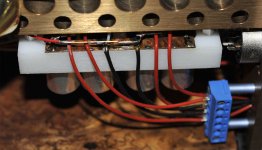Hi Peter
I’ve successfully built another dual mono Bridged LM4780 amp. It sounds impressive. Instead of using two 300VA (22 dual sec) Plitrons, I used two 300VA (22V dual sec) Antrim toroids transformers from Australia. I also used a better quality chassis and I must say there was a distinct improvement to the dynamics of the sound, particularly in the lower frequencies (more heft and punch). Just like you stated, the quality of the chassis and transformers distinctly influence the sound of these amps.
I’m now going to embark on building a dual mono Bridged LM3875 amp using one chassis to house the two transformers and both amplifier channels (4 chips). With regard to Star Grounding should I link the Chassis Grounds to all four PCBs with a thick copper cable and from the centre, ground it to chassis earth (via 10 ohm resistor)? Or should I keep each channel separate with its own star grounding arrangement like what you do with Dual Mono Bridged Patek amp?
I’ve successfully built another dual mono Bridged LM4780 amp. It sounds impressive. Instead of using two 300VA (22 dual sec) Plitrons, I used two 300VA (22V dual sec) Antrim toroids transformers from Australia. I also used a better quality chassis and I must say there was a distinct improvement to the dynamics of the sound, particularly in the lower frequencies (more heft and punch). Just like you stated, the quality of the chassis and transformers distinctly influence the sound of these amps.
I’m now going to embark on building a dual mono Bridged LM3875 amp using one chassis to house the two transformers and both amplifier channels (4 chips). With regard to Star Grounding should I link the Chassis Grounds to all four PCBs with a thick copper cable and from the centre, ground it to chassis earth (via 10 ohm resistor)? Or should I keep each channel separate with its own star grounding arrangement like what you do with Dual Mono Bridged Patek amp?
I did a similar project, however, the transformers were kept separate: http://www.diyaudio.com/forums/showthread.php?s=&threadid=76609&highlight=
Also, the assembly was done p2p without using any boards. I used two 100/50 caps per chip, mounted using a Delrin block. As you can see in attached pic, I used copper strips for local power grounds, all 4 pins from the caps had been soldered to that strip as well the two black ground wires coming from a separate PS. Then with a thin wire I connected power ground and signal ground which was also common for two chips forming a single channel.
When using boards, you can do exactly the same as what I recommend for a stereo star ground application: http://www.diyaudio.com/forums/showpost.php?p=1518369&postcount=77 and then connect local star grounds (center point on a wire connecting OG pads) from both balanced channels to a chassis through 10R resistors, or use CL60 thermistors in place of resistors.
Also, the assembly was done p2p without using any boards. I used two 100/50 caps per chip, mounted using a Delrin block. As you can see in attached pic, I used copper strips for local power grounds, all 4 pins from the caps had been soldered to that strip as well the two black ground wires coming from a separate PS. Then with a thin wire I connected power ground and signal ground which was also common for two chips forming a single channel.
When using boards, you can do exactly the same as what I recommend for a stereo star ground application: http://www.diyaudio.com/forums/showpost.php?p=1518369&postcount=77 and then connect local star grounds (center point on a wire connecting OG pads) from both balanced channels to a chassis through 10R resistors, or use CL60 thermistors in place of resistors.
Attachments
Last edited:
- Status
- Not open for further replies.
